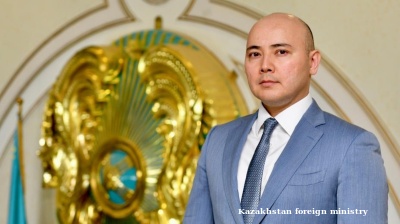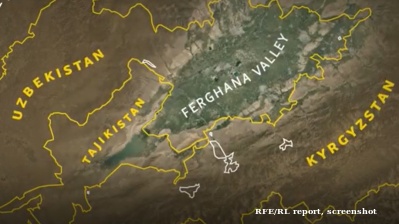India and the Central Asian region have significant untapped potential for trade and investment partnerships, but limited connectivity and logistical bottlenecks continue to constrain growth, according to a new joint report by the Eurasian Development Bank (EDB) and India Exim Bank, presented at a webinar on September 10.
Officials from the two banks highlighted complementarities between the fast-growing Indian economy and resource-rich Central Asia during the webinar, pointing to synergies in agriculture, food processing, textiles, energy and infrastructure. These, it said, show the potential to boost mutual trade and investment. “By capitalising on these complementary strengths, both parties could create mutually rewarding economic relationships,” the report said.
“India’s bilateral engagements with countries in Central Asia have been modest owing to limited connectivity, when compared to other partner countries of the region,” the joint report said. “This relationship could, however, be bolstered by collaboration in sectors like agribusiness, renewable energy, healthcare and pharmaceuticals, IT and ICT, besides the traditional oil and gas sector.”
Fast-growing economies
Harsha Bangari, managing director of India Exim Bank, expanded during the webinar on the “natural synergies” between Central Asia and India, both of which, she pointed out, are fast growing economies.
Central Asia’s combined GDP reached $458bn in 2023, supported by a population of 79mn. Since 1999, the region’s GDP has more than quadrupled in real terms, while the population has grown nearly one and a half times. Kazakhstan remains the largest economy, accounting for 58% of regional output, while Uzbekistan is the most populous, representing 45% of Central Asia’s people.
“Kazakhstan (since 2008) and Turkmenistan (since 2013) are firmly lodged in the upper-middle income group. Uzbekistan, Kyrgyzstan, and Tajikistan joined the lower-middle income group in 2015, 2022, and 2011, respectively,” the report said.
India, meanwhile, is the world’s fifth-largest economy with a GDP of $3.6 trillion in 2023, growing at 8.2% last year. “India emerged as the fastest-growing major economy in the world in 2023, growing at 8.2% through domestic demand and investment activity,” the report said. The country has more than doubled the size of its economy since 2010 and is now a major player in global trade, ranking among the top 10 importers and exporters of goods and services.
Trade expands
Trade between India and Central Asia has expanded steadily. India’s merchandise trade with the region increased from $490mn in 2010 to $1.72bn in 2023, with pharmaceuticals leading exports.
“Central Asia’s location as a land bridge between Asia and Europe imbues it with undeniable strategic importance for India,” said Dr. Viswanath Jandhyala, deputy general manager of India Exim Bank’s Research and Analysis Group.
Kazakhstan is currently India’s primary supplier from the region, accounting for over 64% of Central Asia’s total imports to India, according to Jandhyala, while Uzbekistan has emerged as the leading export destination, accounting for more than 45% of India’s exports to the region.
“There is potential for enhancing the level of bilateral investment. Countries in Central Asia are endowed with rich natural resources including substantial oil and gas reserves and diverse minerals … While investment climates vary across the countries in the region, almost all have implemented politics supported by their respective visions to attract investments,” Jandhyala said.
According to the report, pharmaceutical products accounted for 37.9% of total exports to Central Asia, followed by electrical machinery and equipment (12.1%) and machinery and mechanical appliances (10.4%).
Imports from the region have been more volatile, peaking at $1.7bn in 2019 before moderating to $1.3bn in 2023. Mineral fuels and oils topped the list of imports, accounting for 35.3% of the total, followed by fertilisers (21.3%) and inorganic chemicals (13%).
Below potential
Overall, economists said the figures remain modest given the size of India’s economy and Central Asia’s resource wealth. “International trade remains below potential levels, confined by an arid climate, limitations in connectivity, market access issues, limited bilateral engagement, and difficult trade and transport facilitation,” the report cautioned.
“Transport and logistics are among the main challenges that hinder trade between India and Central Asian countries, because right now air transport is the only direct option. This mainly works for high value, time sensitive goods such as pharmaceuticals and perishable goods. Most goods are shipped through the Suez Canal and the Black Sea ports which can take up to 10,000 kilometres and slow down delivery times,” said Madi Aldanazarov, senior specialist in the EDB’s Research Department. “As we all know, high transport costs can reduce the competitiveness of delivered goods and thus the volume of mutual trade.”
On a positive note, Aldanazarov pointed to the development of the North-South international transport corridor, which when implemented could slash transport and delivery times. The timing, however, is uncertain given holdups related to administrative barriers and infrastructure bottlenecks.
Investment flows have lagged behind trade. Between 2000 and 2024, Indian firms invested just $392mn in Kazakhstan, $24mn in Kyrgyzstan, $18mn in Uzbekistan, and $5mn in Tajikistan, with no recorded investment in Turkmenistan. From 2010 to 2023, India ranked as the 16th-largest investor in Central Asia with $1.5bn in planned capital expenditure across 10 projects. The majority, nearly 80%, went to Kazakhstan, mainly in coal, oil and gas.
“The total investment in the Central Asian region accounted for 0.1% of the total [overseas direct investments] of India during April 2000 to March 2024,” the report said. FDI inflows from Central Asia into India were also negligible, totaling less than $30mn over the past two decades, mostly from Kazakhstan.
Despite the modest figures, the report argued that opportunities for deepening ties are considerable. “The agricultural landscape, encompassing related activities, food processing, and textiles, presents prospective areas for collaboration,” it said. It also highlighted pharmaceuticals, mining, metallurgy, hydrocarbons, renewable energy, logistics and transportation as areas of potential growth.
Features

From World Bank to patriotic homecoming in Indonesia - then dismissal
Indonesia’s long-serving finance minister, Sri Mulyani Indrawati, was abruptly removed from her post in early September and replaced by economist Purbaya Yudhi Sadewa.

INTERVIEW: Kazakhstan repositions as a diversified investment destination
Kazakhstan is doubling down on its drive to attract high-quality foreign investment, said Deputy Minister of Foreign Affairs Alibek Kuantyrov in an interview with bne IntelliNews.

Europe mulls secondary sanctions as part of the nineteenth sanctions package for the first time
The European Union is considering the unprecedented step of adopting US-style secondary sanctions as part of the nineteenth sanctions package currently under review. The EU has never imposed secondary sanctions before.

Stumbling blocks hinder plan to build Trans-Afghan Railway connecting Uzbekistan to Pakistani seaports
Security risks, financing challenges, difficult terrain and lack of recognition for Taliban among headaches.




